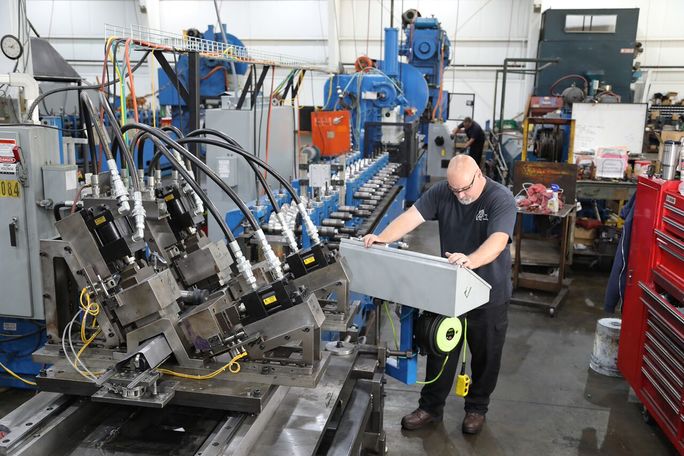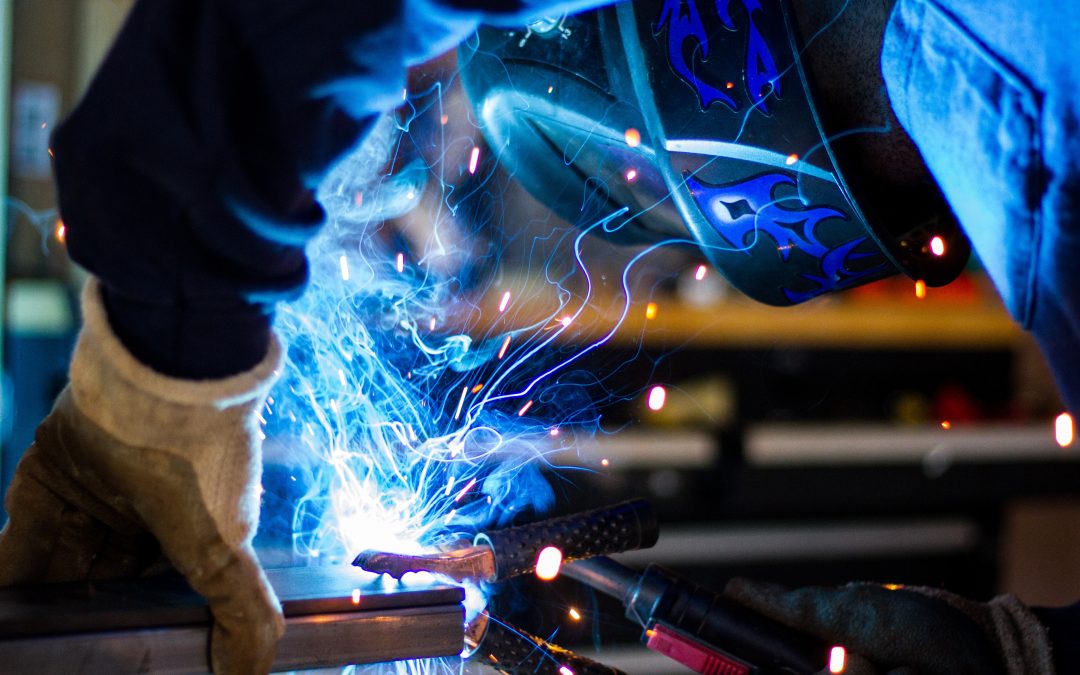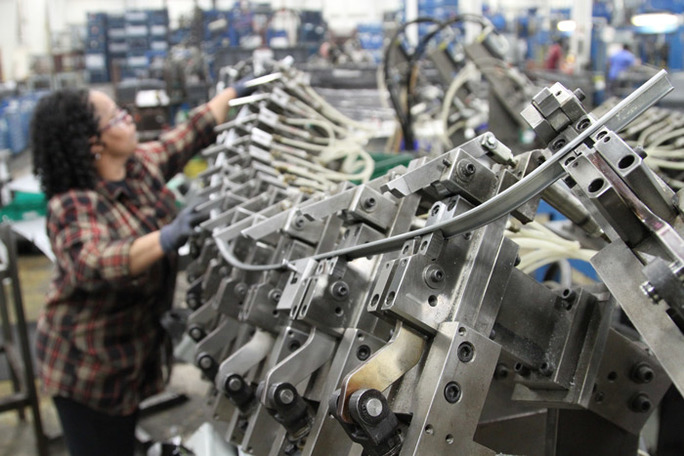
by admin | Nov 22, 2017 | LTC Roll Blog
Metal stamping is the process of placing flat sheets of metal into a stamping press. It forms the metal into a net shape, through a tool and die surface. In the manufacturing industry, metal stamping has evolved over the years. There is now, a world of opportunity in many different stamping-related careers. The most common career options, in metal stamping, include process engineers, die designers, diemakers, setters, and die maintenance technicians. Each metalworking professional has their own diverse set of skills that give them a competitive edge in the manufacturing industry. While you might not have realized this, the art of metal stamping has a strong presence in our lives. Without experts in the industry, many of the common items we use every day would no longer exist. Metal Stamping in Everyday Lives Stamping continues to dramatically change our lives. As the manufacturing industry evolves, through the assistance of technology, the manufacturing industry is constantly producing new ways of stamping. The items you use every day are likely a product of the stamping process. From small items, such as culinary utensils, to medium sized items, such as washers and dryers, tangible products that you often take for granted usually have some form of stamped parts. The car you drive to work every day is a collection of metal parts that were built specifically to meet the unique needs of your vehicle. Meticulously stamped parts comprise many of the elements found on the computer you are using to read this article. Metal Stamping as a Profession While metal stamping is a part of our everyday lives, not many people embrace the beauty in the...

by admin | Nov 8, 2017 | LTC Roll Blog
The manufacturing sector of the U.S. economy continues to be an excellent career option. In the world of digital technology, most students are encouraged to move on to college at the culmination of their high school career. While school is an excellent option for some students, the manufacturing industry provides many benefits as an option over college. While it might seem that technology is taking over the world, there is still a need for tangible goods. As a result, job growth unveils the advantages of choosing the manufacturing industry as an option over college. Benefits of Manufacturing Careers Manufacturing jobs have come a long way. According to the National Association of Manufacturers, it is safe, clean, and efficient. With most students leaving high school to go to college, technical trades continue to drop regarding fulfilled career positions. While this might seem negative, it creates a world of opportunity for those moving into the manufacturing business. As a result, we continue to see an increased awareness of the benefits of the job. Moreover, there are hundreds of thousands of opened positions available to be filled. Therefore, individuals, with the skills and credentials to fill these positions, have a better advantage of landing a job. In addition to the availability of manufacturing positions, these jobs pay a higher hourly rate than most entry-level jobs. Workers in manufacturing often exceed thirty dollars an hour. This pay doesn’t even include the excellent benefits you will get. Manufacturing workers are more likely to have significant employer-provided benefits. These benefits include medical insurance, paid vacation, sick and personal days, and retirement packages. Consider it a huge stress relief...

by admin | Oct 18, 2017 | LTC Roll Blog
Roll forming is the preferred method for most manufacturing companies to create different parts. This is because it is one of the simplest ways to manufacture different parts in large quantities as fast as possible. But what is it exactly? In this article, you will learn everything you need to know about roll forming, a history of then and now. What is Roll Forming? In order to understand roll forming, you first need to know what rolling is. Rolling is a process of metal forming. In this process, metal stock is passed through one or more pairs of rolls to reduce its thickness. It also ensures that the thickness is uniform. With that being said, roll forming is a type of rolling. It involves the continuous bending of a long strip of sheet metal into the desired cross-section. The strip passes through sets of rolls mounted on consecutive stands. Each set performs an incremental part of the bend until the desired look is obtained. This form of rolling is ideal for producing constant-profile parts with long lengths and in large quantities. When Did Roll Forming Begin Roll forming began as early as 600 BCE in the Middle East and South Asia. There, they used the basics of what we know today as a rolling mill. However, more streamlined mills, closer to what we use today, were created across Europe and Britain. The design for these came from drawings done by Leonardo da Vinci. Slitting mills were created first. Slitting mills passed flat bars between rolls to form a plate of iron, which was then passed between grooved rolls to...

by admin | Oct 4, 2017 | LTC Roll Blog
Job openings for manufacturing may be something you are struggling to find. Simply put, that is because you have not been looking in the right place. There are many manufacturing opportunities in Michigan available to you. In this article, you will find out more about the job openings for manufacturing. The Facts According to The National Association of Manufacturers over the next decade, nearly 3½ million manufacturing jobs will likely be needed. They also say that manufacturers contributed $2.18 trillion to the U.S. economy in 2016. In 2016, manufacturing accounted for 11.7 percent of GDP in the economy. What does all of this tell us? It tells us that manufacturing is a booming business that continuously needs more people who are qualified individuals. There are many job openings for manufacturing now, and they will only continue to rise. Why are These Numbers So High The numbers above are so high because of supply and demand. Manufacturing in the United States is the ninth-largest economy in the world. With $2.1 trillion in value added from manufacturing in 2014, only eight other nations (including the U.S.) would rank higher in terms of their gross domestic product. Americans work hard to earn their money. However, interesting advertisements, ‘last minute’ check out items, and cool colors or designs send us reaching for our wallets. This creates more demand as stated earlier. With the demand comes the need for more job opportunities for manufacturing. The workers themselves receive great benefits because of this. In 2015, the average manufacturing worker in the United States earned $81,289 annually, including pay and benefits. The average worker in all nonfarm...

by admin | Sep 20, 2017 | LTC Roll Blog
At LTC Roll and Engineering, we are continuing to see growth and expansion. For this reason we’re making some space in our tool room. In 1967, we started a journey to provide the best roll formed tooling available. In the 50 years since then, we’ve grown into one of the world’s leading providers of quality rolled and stamped metal parts for the automotive industry. This also includes the largest car manufacturers in the world. As we move forward, we are pausing to reflect on where we’ve been, celebrating our achievements, and looking at the path ahead. A History of Growth The early goals of the company was to deliver on-time, all the time, completely defect-free products to our customers. We set standards for the best quality tools while maintaining unbeatable levels of efficiency. Those first ten years were challenging, but so rewarding, and in them, we saw significant growth. In 1977, the company turned its sights toward manufacturing parts. Acquiring additional space and tooling, LTC Roll and Engineering realized its knack for manufacturing quality products and at competitive prices. The late 1980s saw expansion to a larger facility and continued growth in the quality and reputation of LTC Roll and Engineering’s work. In the new millennium, the growth and expansion continued. In 2001, an additional 150,000 square feet of manufacturing space was opened to foster even more growth. We are and have always been, proud to be a leader in the vast tradition of manufacturing in the United States. We have even expanded beyond our borders, enhancing the experience of, and service to, our customers. Expansion in Mexico LTC Roll and Engineering...

by admin | Sep 6, 2017 | LTC Roll Blog
Every company that produces or manufactures anything knows that you have to live and breathe quality control. This can be tedious. However, nothing is more important when you are manufacturing products, especially ones that are going to be used by consumers. As a result, safety and functionality must be right every time. For this reason, the International Automotive Task Force (IATF) developed standards of quality control for the automotive industry. Here we will overview the IAFT, their new certification IATF 16949, and some other components of quality control. Who is IATF? The International Automotive Task Force describes themselves as an ad hoc group. Their purpose is to work to provide continuity, consensus, and improved quality around the globe in the automotive industry. With widely accepted standards, registration schemes, and training material, they are the “go to source” for automotive manufacturing quality. With this in mind, LTC Roll and engineering recognizes and seeks to adhere to these standards. It is our desire to offer the best products to automotive manufacturers around the world. The New Certification IATF 16949 This new certification is a replacement for the ISO/TS 16949. Given that, its primary goal and purpose are to inform automotive industry manufacturers about the processes that best lead to quality. These specifically relate to companies’ organizational systems and how they relate to and foster quality. Training and compliance will get a company to certification, an essential factor for automotive manufacturing companies. The 2016 update contains many changes and additions for businesses to learn, process, and integrate into their structure. Compliance Thankfully, there are dozens of websites online that can help a company register for the training and compliance...
by admin | Aug 24, 2017 | LTC Roll Blog
LTC Roll has become a nationally, and internationally, recognized leader in progressive die stamping. Our highly skilled and proficient team do more than make quality parts quickly, affordably, and efficiently. Moreover, our years of experience add continued value to our client’s experience. Here is an overview of what it is and why we offer it as one of our four main competencies. What is Progressive Die Stamping? Progressive die stamping is a widely used process for forming raw sheets of metal into varying parts for different client applications. As the name signifies, it is a process with many progressive steps. Each step builds on the one before it, to create the part our client desires. While each part has some potential variations in the process, the basic setup is similar and follows the following basic steps: 1. First, a skilled employee inserts the strip of sheet metal into the die. Once placed correctly, the technician triggers the machine. 2. Next, they adjust the strip and move it to the next step in the progression. The machine is then triggered again. 3. This process is repeated over and over again throughout the shift. The number of steps in the process varies per part manufactured, but the result is the same. Once a section of metal goes through each step, the final step cuts the part of the larger sheet, which is then checked by the technician and placed with other completed parts. What are the Benefits of Progressive Die Stamping? One major advantage is the use of materials. The level of precision at which the dies...
by admin | Aug 10, 2017 | LTC Roll Blog
When you think manufacturing, what do you picture? A dirty man in overalls sweating next to a smelting fire, right? Maybe not that exactly, but for the typical American, an iconic image on a manufacturing floor from the first half of the 20th century usually comes to mind. But today’s manufacturing is far from that. In fact women in manufacturing are changing the game. Sure, the look of manufacturing changes with more women involved because they look different than men, but that’s not what we have in mind. We’re talking about the perception of manufacturing being what you do when you have no education and no connections. Women in manufacturing are highly skilled workers who are sought after by manufacturing employers because they make businesses better, improve working environments, and broaden the skills of the companies for which they work. Women are Making Companies More Competitive Research has shown that diversity in a company’s workforce increases their competition with other businesses. Given that women are the largest section of the workforce, there is a great opportunity for women in manufacturing to raise the bar. Unfortunately, they are massively underrepresented in this industry. However, that only means that more opportunity exists for women to compete for these roles. Diversity’s Wonderful Side Effect It’s a little-known fact that diversity breeds happier employees that are more likely to stay with their companies. However, that’s exactly what research from 2013 shows. There is a connection between diversity and intent to stay. Since hiring women in manufacturing jobs brings more diversity to companies, it also increases the likelihood of employees...

by admin | Jul 27, 2017 | LTC Roll Blog
Companies have long sought to capitalize on benefits by moving certain aspects of their business to other countries. In the United States, China has dominated this conversation in recent years. However, there are many reasons to consider the advantages of manufacturing in Mexico for U.S. companies looking to diversify their manufacturing options. In this article, we’ve listed five advantages of manufacturing in Mexico. Low Cost, High Skill It’s commonly been the assumption that manufacturing in Mexico is cheaper than the U.S., which is true, but what is often not known is the significant skill level of Mexican workers. The country graduates hundreds of thousands of skilled workers each year in an area that is massively literate and whose education system is substantial and growing. Additionally, the labor force is known both by reputation and research to be highly dependable. High quality coupled with low wages gives a complete picture of manufacturing in Mexico Affordable Infrastructure Wages aren’t the only place businesses see savings, though. Manufacturing in Mexico offers a modern infrastructure that is quite affordable. Estimates in the U.S. suggest the average real estate cost per square foot between $9 and $20, whereas many estimates put it below $5 for Mexico. With this infrastructure comes easy access to the U.S. by air, land, or sea. Shipping can happen in cargo ships or semi-trucks, but business can also capitalize on U.S. rate structures for major shipping corporations. Proximity to the U.S. Shipping provides the perfect segue to the next advantage of manufacturing in Mexico: Proximity to the U.S. This is not only an advantage because of shipping, but also for...

by admin | Jul 20, 2017 | LTC Roll Blog
Manufacturing has long been one of the mainstays of the American economy. Today, it still makes up a significant portion of the GDP in the United States. However, one of the major issues facing the industry is the issue of women in manufacturing. Here, we’ve compiled ten important facts about women in manufacturing that you should know regardless of your gender. The Growing Need for Women Surprisingly, there is a growing desire for women in manufacturing jobs today. Even news articles and editorials note the importance of women in manufacturing. Moreover, there have been studies on the number of women in manufacturing and the barriers they face. Thankfully, their support organizations and schools help pave a way forward. Depending on the numbers at any given time, there are approximately 600,000 open manufacturing jobs, and women are the largest demographic pool that can help meet this need. Women in Manufacturing are Decreasing Sadly, in a time when manufacturing grew significantly, the number of women in the industry decreased. Many facts about women in manufacturing are puzzling. For example, from 2010-2013 manufacturing jobs increased by over 500,000, but women lost more than 28,000 jobs in that sector. Both historically and currently, manufacturing has been dominated by men. However, a multi-level effort is underway to change the tide and fully open this field up for women. Success and Gender Diversification Believe it or not, there is a link between company success and gender diversification. Research statistics prove that companies with women in leadership roles show increased rates of innovation and problem-solving. They also experience a higher return on equity, better annual valuation,...













